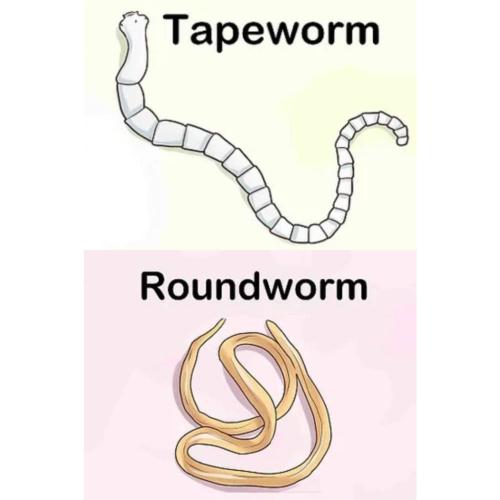Intestinal Worms Endoparasites are parasites which live inside a host and generally inhabit areas such as the gut, lungs, heart and blood vessels. The most common endoparasites affecting our dogs in the UK and Ireland are Intestinal Worms, which can be categorised into 2 types - Cestodes and Nematodes.
Worms are parasites which need a host in order to complete their life cycle, such as your cat or dog. Although simple in structure, worms have been on Earth for millions of years. During this time they have evolved into thousands of different species, and adapted to live in many strange places, including inside our pets. Worms can be picked up from the environment, from ingesting infected prey or from fleas.
The main worms which affect our pets in the UK and Ireland are Roundworms (Toxocara cati – cats, Toxocara canis – dogs) and Tapeworms (Taenia species, Dipylidium caninum, Echinococcus granulosus). Pet owners should also be aware of less common endoparasites including Lungworms (Aelurostrongylus abstrusus – cats, Angiostrongylus vasorum – dogs), Hookworms (Uncinaria stenocephala – cats and dogs, Ancylostoma tubaeforme – cats, Ancylostoma caninum – dogs), Heartworms (Dirofilaria immitis) and Whipworms (Trichuris vulpis).
By committing and sticking to a regular worming routine, you can help reduce the risk of both your pet and your family becoming infested by worms. RoundwormRoundworms are spaghetti-like worms that live in your pet’s intestines feeding on partially digested food, and can grow up to a few inches long. Almost all dogs have roundworms at some point in their lives, most often in puppyhood as the larvae are often transmitted from the mother just before birth or through nursing.
Puppies and dogs can become infected with roundworms by accidentally ingesting eggs from the environment as eggs can be present in soil or on plants or other objects, or from eating infected animals. Roundworm eggs can also be carried by small animals such as rodents, earthworms, birds, and some insects. These animals are not the roundworm’s normal host, so in these species the egg never matures, but if a dog eats an infected animal, the egg can activate and grow into a roundworm once inside the dog's stomach, from where they will migrate around the body.
In young kittens and puppies, who have not yet developed an immune response to the parasites, the roundworm larva reaches the lungs, burrows into an air sac, and continues to the wind pipe. As the roundworm crawls up the windpipe it irritates the throat, causing the kitten or puppy to cough up the roundworm larva and swallow it back into the stomach. Here, the roundworm continues maturing into an adult and lays more eggs, which are released into the environment via the pet’s faeces.
In healthy, adult dogs, who have a strong immune response, roundworms are usually prevented from completing their journey. Instead, the roundworm larva is diverted to the muscles where it forms a dormant cyst. These cysts can remain dormant for many years, and do not harm your dog in this state. It is only when your pet’s immune system becomes compromised (due to age, illness or pregnancy) that the roundworm larvae become active again and are able to complete their journey to the intestines.
Roundworm eggs can lay dormant in the environment for over a year, and are particularly sticky so easily attach to fur, paws or noses. Roundworm eggs are also extremely small, so you are unlikely to see them on your pet. After ingestion as eggs, the roundworms continue their life cycle inside your pet.
Roundworms are also the most common type of worm that can be transmitted to humans. Fortunately, you can minimise the risk of getting a roundworm infestation yourself by disposing of pet faeces quickly and safely and washing your hands after handling faeces.
It is very possible that an animal, particularly a puppy or kitten, can have a small colonisation of roundworms yet not be showing any symptoms, so it is important to treat dogs and cats for roundworms on a regular basis, according to the instructions of the product you choose. For young animals, treatment every 2 weeks is usually recommended.
When symptoms of a roundworm infestation are present, they may include a pot-bellied appearance due to the abdominal swelling and distention caused by having multiple adult worms in the intestines, coughing when the larvae have migrated to the lungs, a change in appetite or signs of malnutrition, and vomiting or diarrhea.
TapewormClassic tapeworms (Taenia species), one of the most common types of worm to afflict cats and dogs in the UK, are flat worms made up of a string of segments all linked together. Tapeworm infestations occur when a cat or dog ingests an infected intermediate host. This could occur after hunting and/or eating infected prey, or during grooming.
In order to complete their life cycle tapeworms need an additional intermediate host. For a Taenia tapeworm, this may be a mouse or a rabbit, for Dipylidium caninum it’s usually a flea or louse, and for Echinococcus granulosus this is usually livestock.
In your pet’s stomach, the intermediate host is digested but the tapeworm larva produces anti-enzymes to protect itself. Once released, the tapeworm larva will travel to the intestines and attach its mouthparts to the gut wall. Here, the tapeworm will grow into a string of segments and continue to mature to adulthood. At this point it will release egg-filled segments from the end of the string, which will be passed in your pet’s faeces.
Dipylidium caninum tapeworm segments often resemble grains of rice. Taenia tapeworms are flat worms made up of a string of segments which are also known as Proglottids, with the total adult tapeworm usually measuring anywhere from 4 to 28 inches in length. These segments may be seen in pet’s faeces, around the bottom or back legs, and are often the first indication to an onwer that their pet is harbouring an infestation. Once dried out, the segment will burst open, releasing thousands of tapeworm eggs into the environment and the whole process starts again.
Echinococcus granulosus is rare in the UK. They are mostly located in more remote parts of the country, such as areas of Wales, parts of South Herefordshire and the Western Isles of Scotland. The intermediate host is usually a sheep, so dogs who are scavengers or fed raw offal are at risk of becoming infected. Echinococcus granulosus is one of the few tapeworms that is also zoonotic, meaning that this species of tapeworm can be transmitted to humans. However, the risk of infestation is very low, you’ would have to swallow an infected flea or, in the case of some species of parasites, via the accidental ingestion of feces that is carrying parasitic eggs. Children are most prone to this, since they’re more likely to be outside playing in grass, parks, and other areas where dog waste might be left.
The proglottid segments can sometimes be seen crawling near the anus or on the surface of fresh waste. These eggs are released into the environment when the proglottid dries out. The dried proglottids can sometimes be seen stuck to your dog’s fur. Another telltale sign of worm infestation is if your dog rubs their bottom across the ground, on a rug, or another rough surface. This is due to the irritation the segments are causing his skin, so you may see your dog licking or biting at the area. Occasionally, a portion of the tapeworm will be released when your dog vomits.
Less Common WormsLungworms, also known as French Heartworms, prefer a warmer climate than is usually found in the UK and Ireland and so are less common here, however incidences have been rising in recent years. Lungworms mostly affect dogs, who can become infested when they eat infected slugs or snails. Lungworms live in the blood vessels supplying the heart, and the larvae burrow into the lungs. Symptoms of lungworms in cats and dogs include respiratory issues, coughing, lethargy, blood clotting problems (dogs only) and unexplained bruising (dogs only).
Heartworms are not currently present in the UK. But, if your pet travels abroad with you they could be at risk as mosquitos transmit heartworms. Symptoms of heartworms in cats and dogs include coughing, loss of condition and collapse.
Hookworms are a type of roundworm, that can have serious health consequences for pets. Hookworms are small worms that live in the intestines and usually grow to between 5 and 16mm in length. They are so called because adults ‘hook’ their mouthparts onto the gut wall and feed off your pet’s blood, causing anaemia and damage to the gut wall. The Ancylostoma caninum hookworm is common in central and southern Europe. The Uncinaria stenocephala hookworm is also known as the ‘northern hookworm’ due to its ability to tolerate colder climates but, despite this, it is still considered an uncommon type of worm in the UK. However, studies have estimated that 7 out of 10 foxes in the UK carry hookworm, which increases the risk of dogs becoming infected. In cats, hookworms are very rare in the UK. Hookworms are hard to spot, but some symptoms include blood in the faeces, diarrhoea, lesions on the feet as hookworms can get into pets by penetrating the skin and poor appetite.
Whipworms are threadlike in appearance with a thick tail end, whipworms grow from 50 to 76mm long. They live in the last part of the small intestine and the first part of the large intestine. The female whipworm can go for long periods of time without laying eggs, which can make them difficult to diagnose. Whipworms are rare in the UK, but pets who travel abroad with their owners may be at risk.
If you are concered about Lungworm, Heartworm, Hookworm or Whipworm, you must speak to your vet. Over the counter medications are not tested or licensed for use against these endoparasites and specialist treatments are required to treat infestations of these less common worms.
Choosing a WormerMost wormers are designed to be used every 3 months in adult dogs. Unlike some flea treatments, which act for a continued period of time after administration, worming treatments work by killing only the existing worms in the dog when treatment is given. There is no residual effect so nothing will prevent your dog picking up worms in the first place, however if the worms are killed regularly they will not have a chance to cause any damage.
All pet medicines must pass stringent testing to prove they are effective and safe before they are sold, regardless of whether they are available 'over the counter' or must be prescribed by a vet. All parasite control treatments available at Pet Connection have been proven effective and safe for pets, their owners and the environment, when used according to the instructions on the packaging. If you are concerned or unsure about the most suitable product for your pet, please feel free to contact us and we can provide information and advice.
It is of utmost importance that pets are dosed correctly for their bodyweight, to ensure that treatment is both safe and effective, and we have weighing scales in our Dublin Road store which are totally free to use if required. |







